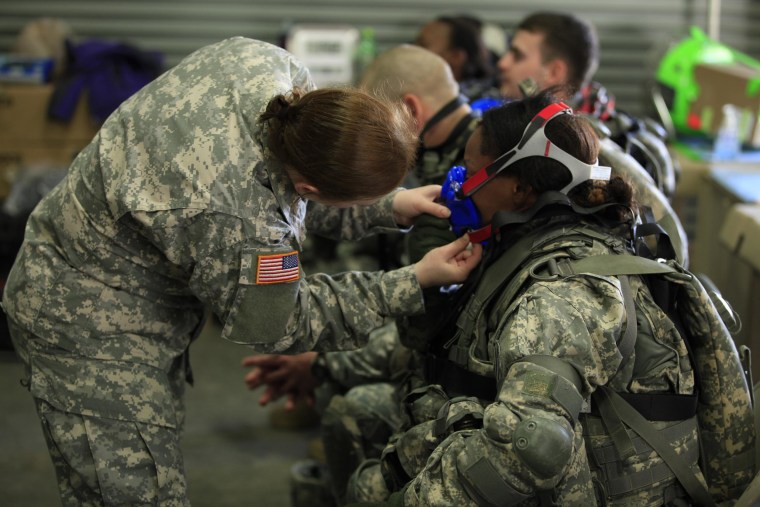FORT STEWART, Ga. — With her blonde hair tucked inside a camouflaged helmet and some 80 pounds of gear wrapped around her petite body, Army Sgt. Jennifer Lancaster stretches her arms to reach the top of a 6-foot high wall in front of her.
She grabs on to the edge of the wooden structure, pulls herself up and climbs on to the other side. The 32-year-old mother of two then steadies her breath to get ready for the next test.
On drizzly morning this week, Sgt. Lancaster — normally a paralegal with the 3rd Infantry Division — has traded her office for a muddy field. She has volunteered to climb walls, lift metal containers and load missiles launchers, as a team of scientists times her performance and measures her oxygen consumption and heart rate.
"I don't have as much upper body strength as the males ... Men lift it with their arms and we do more of a squat to use our lower body."
"Coming from the paralegal world where I lift files, to lifting 65 or 107 pounds, this is definitely demanding," said the sergeant who trained for 5 weeks alongside male soldiers for the nationwide “U.S. Army Physical Demands Study.”
The data will be used to develop unisex performance tests that will become the Army’s standard for determining whether a soldier is fit for combat, regardless of gender.
Designing the fit-to-fight tests is part of the armed forces' efforts to prepare for Jan. 1, 2016, the date women will be allowed to apply for all front-line positions according to new Pentagon rules. Approximately 200,000 of the Army's jobs are battle related, in fields such as infantry, artillery and combat engineering.

Few Army women will be applying for those jobs if the results of a recent poll reflect reality. Only 7.5 percent of the 30,000 who responded to the survey sent to all female members said they wanted a combat position.
But Army Intelligence Officer Autumn Claybaugh would consider it.
"It's always something that I’ve known as a possibility and now it's more so," she said. "I joined to serve my country in whatever capacity that is."
That survey also revealed some male soldiers are deeply concerned women are not physically strong enough to perform at the level combat requires.
Specialist Christina Hood noted that women find ways of overcoming physical challenges.
"I don't have as much upper body strength as the males," said the 28-year-old, describing how she uses her knee to load a TOW missile launcher on a Bradley Fighting Vehicle, about a 50 pound load. "Men lift it with their arms and we do more of a squat to use our lower body."
Maj. Gen. Mike Murray, the commanding officer at Ft. Stewart, one of the bases where the physical demands study is underway, said he hopes standardized performance tests will dissipate concerns expressed in the survey by showing that women can perform as well as men.
"Coming from the paralegal world where I lift files, to lifting 65 or 107 pounds, this is definitely demanding."
But after 32 years of experience in the armed forces, the general believes scientific tests may show the physical demands of some careers make them unsuitable for women.
"There may be specific M.O.S. (Military Occupation Specialties) we can't integrate," said Murray. "It's about finding the best qualified soldiers for the job."
Sgt. Lancaster smiles after completing all tests. The paralegal, who is married to an infantryman, said she is proud her disciplined training allowed her to complete the same tasks as her husband during the study.
"Doing those tasks over and over again built up those muscles." said Lancaster.
But she is most proud of playing a role in the reshaping of an Army that will open new jobs to women.
"I wanted to be part of the physical demands study to help open doors."
